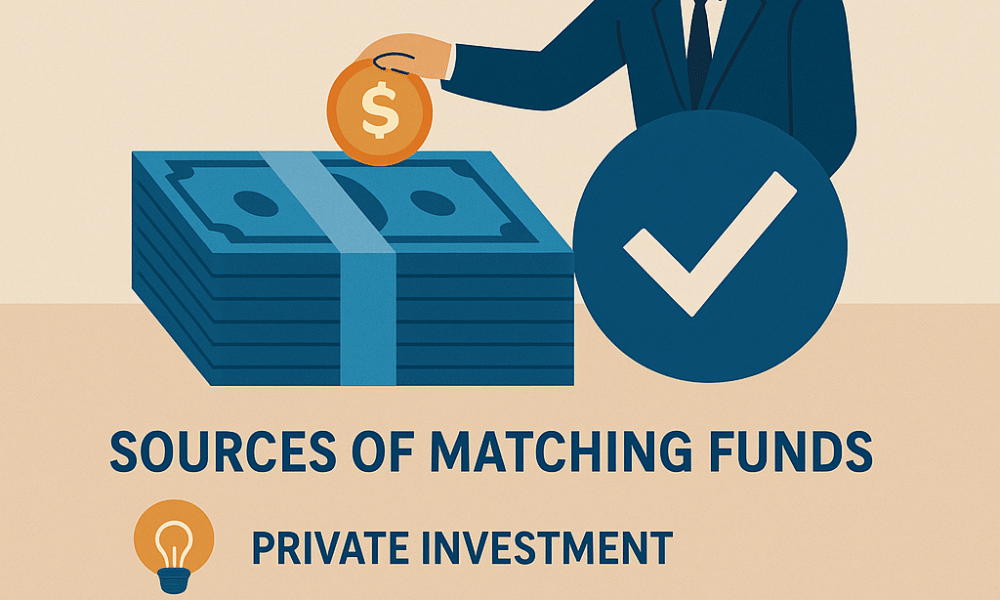For startups advancing to Phase II and beyond in the SBIR/STTR program, the cost match requirement can be a pivotal consideration. While the non-dilutive funding provided by these programs supports significant R&D efforts, some Phase II and later-stage awards may require matching funds to demonstrate financial commitment and sustainability. Understanding how this requirement works and how to plan financially can position your business for long-term success.
What is the Cost Match Requirement?
In some SBIR/STTR Phase II programs—particularly those administered by the Department of Defense (DoD) or Department of Energy (DOE)—matching funds are required to secure the award. The cost match is designed to:
- Demonstrate commercialization potential: By contributing financial resources, startups show their commitment to moving the project toward market readiness.
- Encourage private-sector investment: The requirement often signals that the innovation has value and can attract additional non-government funding.
- Share financial responsibility: Cost matching ensures that both the federal government and the startup invest in the success of the project.
The matching amount and conditions vary by agency and program, but startups are typically required to secure a percentage of the total project cost from private or non-federal sources.
Sources of Matching Funds
There are several potential sources for matching funds:
- Private Investment: This may include venture capital, angel investors, or corporate partnerships.
- Revenue Reinvestment: If your startup generates revenue, allocating a portion toward the match can be a viable strategy.
- State and Local Programs: Some states offer grants or loans that can be used as matching funds for federal programs.
- Non-Dilutive Funds: In some cases, non-federal, non-dilutive grants or awards can contribute to the match.
Financial Planning for Cost Matching
Securing matching funds requires proactive financial planning. Here are key steps to consider:
- Build Early Relationships: Begin conversations with potential investors, partners, or grant providers well before submitting your Phase II proposal. Establishing relationships early can make securing funds smoother when the time comes.
- Create a Detailed Financial Plan: Demonstrate how the matching funds will be used to complement the SBIR/STTR award. A clear breakdown of fund allocation increases confidence in your financial management.
- Explore Alternative Funding Streams: Look beyond traditional sources to ensure you have options that align with your long-term goals.
- Document Commitment: Some agencies may require letters of commitment from funders to verify the match. Ensure you have the necessary documentation ready.
Maximizing the Impact of Matching Funds
Matching funds aren’t just about meeting a requirement—they can enhance your proposal by demonstrating readiness for commercialization. By strategically aligning these funds with project milestones, you can:
- Showcase a strong market-entry plan.
- Strengthen partnerships with investors and collaborators.
- Highlight your startup’s ability to scale.
Challenges and Solutions
Cost matching can be daunting, especially for early-stage companies. However, careful preparation can mitigate common challenges:
- Challenge: Difficulty securing private investment.
- Solution: Explore partnerships with industry organizations or apply for state-level matching programs.
- Challenge: Timing misalignment between funding cycles.
- Solution: Plan your funding strategy to align with key deadlines and ensure cash flow readiness.
- Challenge: Managing risk while raising capital.
- Solution: Structure funding agreements to balance stakeholder expectations and minimize dilution.
The Path to Sustainable Growth
Navigating the cost match requirement is an opportunity to demonstrate financial resilience and market potential. By showing that your business has the resources and partnerships to sustain growth, you position yourself as a credible contender for larger funding awards.
At E.B. Howard Consulting, we collaborate with small businesses to develop financial strategies that meet cost match requirements while reinforcing their commercialization goals. From identifying viable funding sources to creating detailed financial plans, we support your journey to sustainable growth.
If you’re preparing for a Phase II proposal and want to align your funding strategy with program expectations, reach out to us. Together, we can ensure your business is equipped to meet cost-match requirements and achieve long-term success.
Ready To Take the Next Step?
We assist our clients in locating, applying for, and evaluating the outcomes of non-dilutive grant funding. We believe non-dilutive funding is a crucial tool for mitigating investment risks, and we are dedicated to guiding our clients through the entire process—from identifying the most suitable opportunities to submitting and managing grant applications.
